PHYS1160 Essay: Exploring the Earliest Evidence of Life on Earth
VerifiedAdded on 2022/08/20
|9
|2494
|21
Essay
AI Summary
This essay provides a comprehensive overview of the earliest evidence for life on Earth, tracing the scientific discoveries that illuminate the planet's biological origins. It begins by examining the earliest fossil evidence, including small filaments, tubes, and knobs found in ancient Canadian rocks, and discusses the significance of microfossils and chemical signatures. The essay explores the role of hydrothermal vents, meteorites containing liquid water and prebiotic organic substances, and the emergence of life shortly after the oceans formed. It delves into the evidence of microbial mats, stromatolites, and the development of photosynthesis, as well as the search for a last universal common ancestor (LUCA). The essay also touches upon the challenges of identifying non-biological processes that can mimic the signatures of life, providing a rich understanding of the scientific quest to understand life's earliest beginnings on Earth.
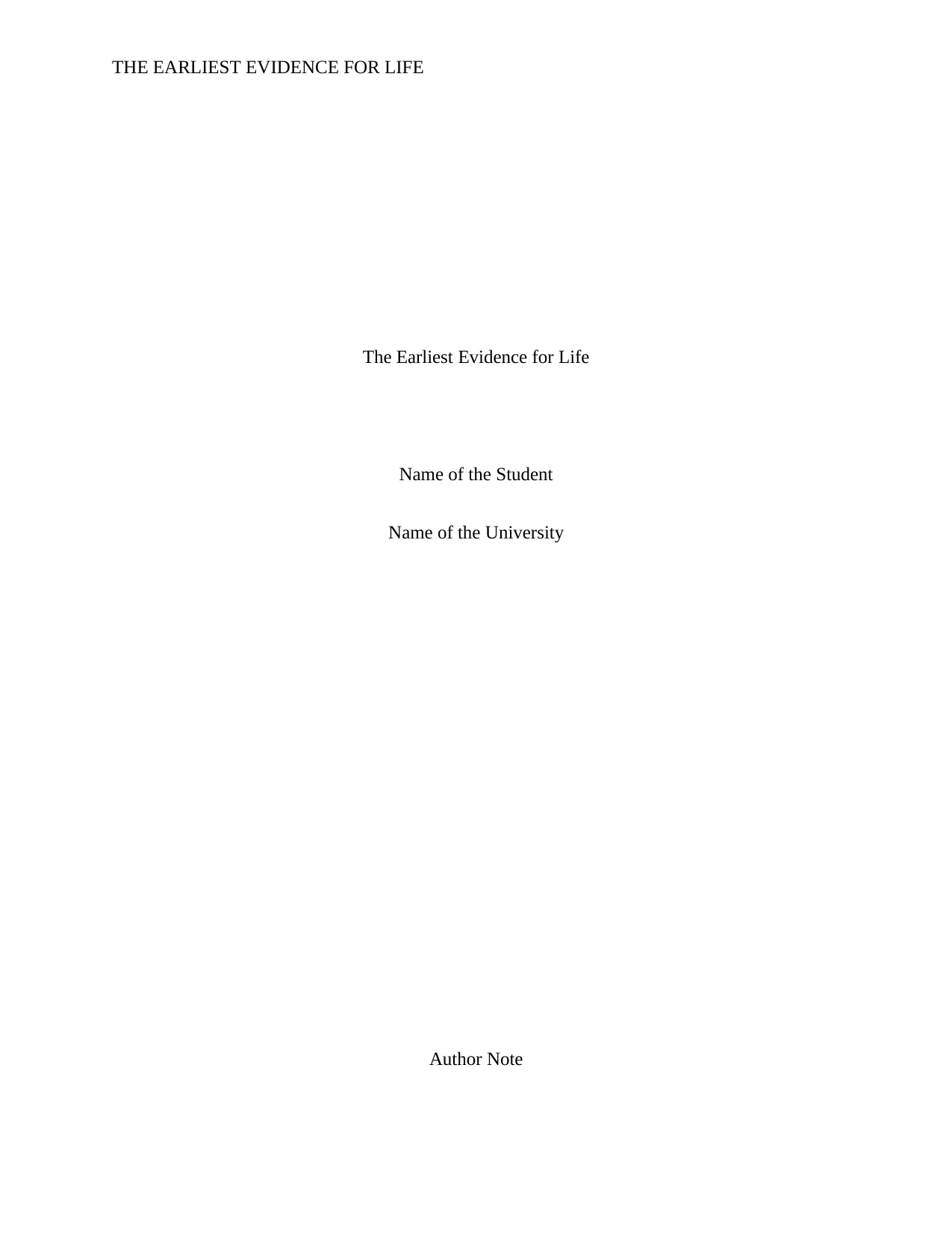
THE EARLIEST EVIDENCE FOR LIFE
The Earliest Evidence for Life
Name of the Student
Name of the University
Author Note
The Earliest Evidence for Life
Name of the Student
Name of the University
Author Note
Paraphrase This Document
Need a fresh take? Get an instant paraphrase of this document with our AI Paraphraser
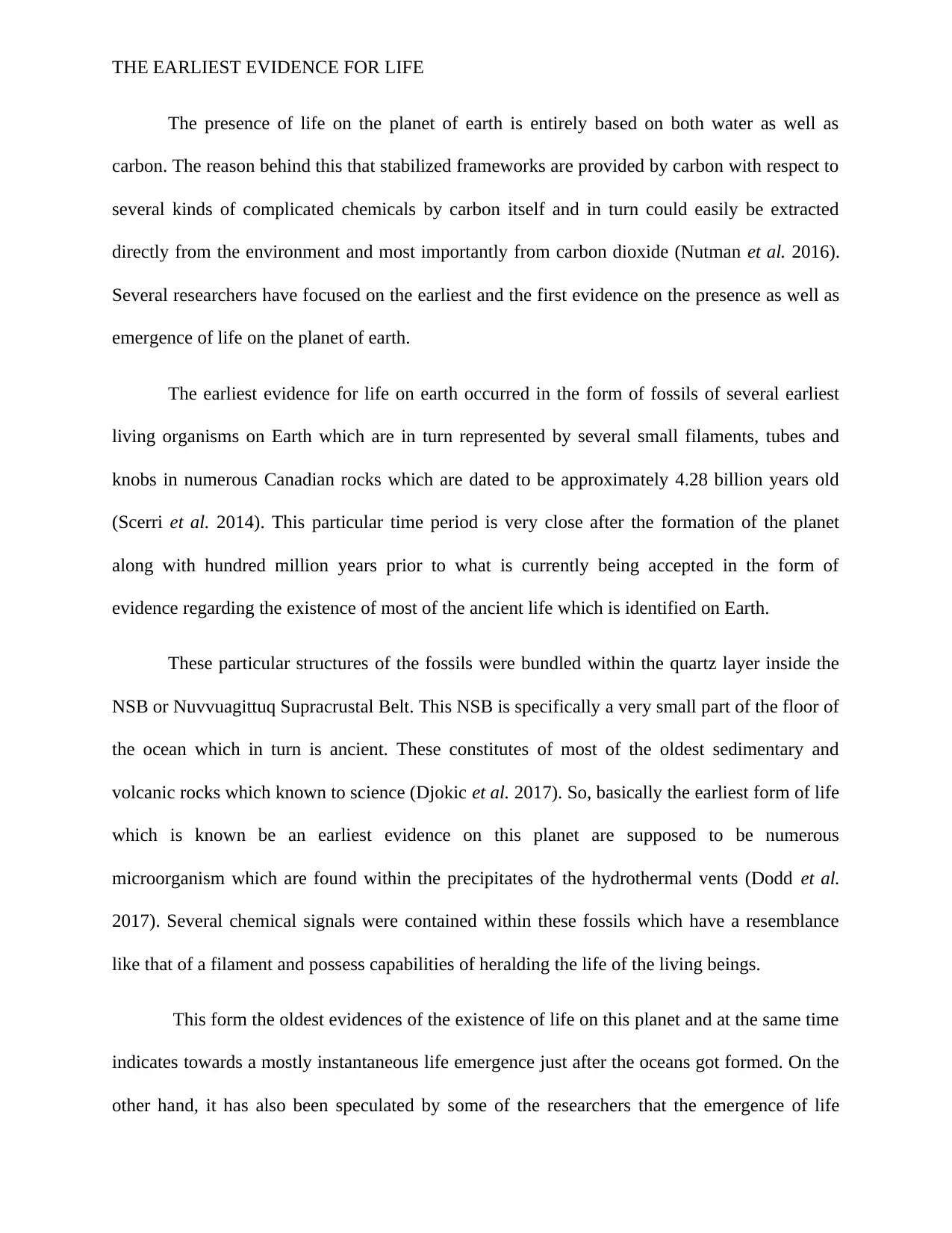
THE EARLIEST EVIDENCE FOR LIFE
The presence of life on the planet of earth is entirely based on both water as well as
carbon. The reason behind this that stabilized frameworks are provided by carbon with respect to
several kinds of complicated chemicals by carbon itself and in turn could easily be extracted
directly from the environment and most importantly from carbon dioxide (Nutman et al. 2016).
Several researchers have focused on the earliest and the first evidence on the presence as well as
emergence of life on the planet of earth.
The earliest evidence for life on earth occurred in the form of fossils of several earliest
living organisms on Earth which are in turn represented by several small filaments, tubes and
knobs in numerous Canadian rocks which are dated to be approximately 4.28 billion years old
(Scerri et al. 2014). This particular time period is very close after the formation of the planet
along with hundred million years prior to what is currently being accepted in the form of
evidence regarding the existence of most of the ancient life which is identified on Earth.
These particular structures of the fossils were bundled within the quartz layer inside the
NSB or Nuvvuagittuq Supracrustal Belt. This NSB is specifically a very small part of the floor of
the ocean which in turn is ancient. These constitutes of most of the oldest sedimentary and
volcanic rocks which known to science (Djokic et al. 2017). So, basically the earliest form of life
which is known be an earliest evidence on this planet are supposed to be numerous
microorganism which are found within the precipitates of the hydrothermal vents (Dodd et al.
2017). Several chemical signals were contained within these fossils which have a resemblance
like that of a filament and possess capabilities of heralding the life of the living beings.
This form the oldest evidences of the existence of life on this planet and at the same time
indicates towards a mostly instantaneous life emergence just after the oceans got formed. On the
other hand, it has also been speculated by some of the researchers that the emergence of life
The presence of life on the planet of earth is entirely based on both water as well as
carbon. The reason behind this that stabilized frameworks are provided by carbon with respect to
several kinds of complicated chemicals by carbon itself and in turn could easily be extracted
directly from the environment and most importantly from carbon dioxide (Nutman et al. 2016).
Several researchers have focused on the earliest and the first evidence on the presence as well as
emergence of life on the planet of earth.
The earliest evidence for life on earth occurred in the form of fossils of several earliest
living organisms on Earth which are in turn represented by several small filaments, tubes and
knobs in numerous Canadian rocks which are dated to be approximately 4.28 billion years old
(Scerri et al. 2014). This particular time period is very close after the formation of the planet
along with hundred million years prior to what is currently being accepted in the form of
evidence regarding the existence of most of the ancient life which is identified on Earth.
These particular structures of the fossils were bundled within the quartz layer inside the
NSB or Nuvvuagittuq Supracrustal Belt. This NSB is specifically a very small part of the floor of
the ocean which in turn is ancient. These constitutes of most of the oldest sedimentary and
volcanic rocks which known to science (Djokic et al. 2017). So, basically the earliest form of life
which is known be an earliest evidence on this planet are supposed to be numerous
microorganism which are found within the precipitates of the hydrothermal vents (Dodd et al.
2017). Several chemical signals were contained within these fossils which have a resemblance
like that of a filament and possess capabilities of heralding the life of the living beings.
This form the oldest evidences of the existence of life on this planet and at the same time
indicates towards a mostly instantaneous life emergence just after the oceans got formed. On the
other hand, it has also been speculated by some of the researchers that the emergence of life
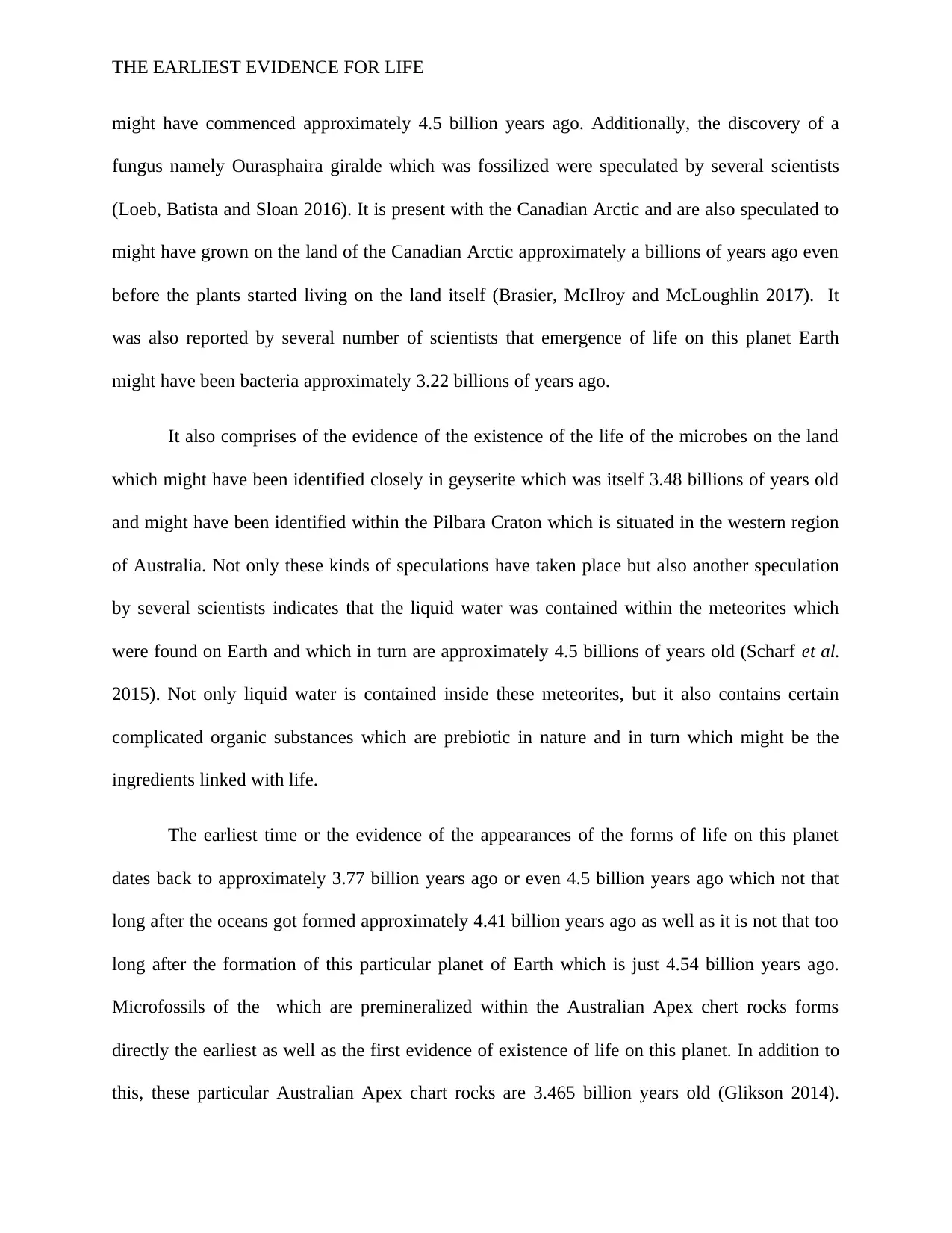
THE EARLIEST EVIDENCE FOR LIFE
might have commenced approximately 4.5 billion years ago. Additionally, the discovery of a
fungus namely Ourasphaira giralde which was fossilized were speculated by several scientists
(Loeb, Batista and Sloan 2016). It is present with the Canadian Arctic and are also speculated to
might have grown on the land of the Canadian Arctic approximately a billions of years ago even
before the plants started living on the land itself (Brasier, McIlroy and McLoughlin 2017). It
was also reported by several number of scientists that emergence of life on this planet Earth
might have been bacteria approximately 3.22 billions of years ago.
It also comprises of the evidence of the existence of the life of the microbes on the land
which might have been identified closely in geyserite which was itself 3.48 billions of years old
and might have been identified within the Pilbara Craton which is situated in the western region
of Australia. Not only these kinds of speculations have taken place but also another speculation
by several scientists indicates that the liquid water was contained within the meteorites which
were found on Earth and which in turn are approximately 4.5 billions of years old (Scharf et al.
2015). Not only liquid water is contained inside these meteorites, but it also contains certain
complicated organic substances which are prebiotic in nature and in turn which might be the
ingredients linked with life.
The earliest time or the evidence of the appearances of the forms of life on this planet
dates back to approximately 3.77 billion years ago or even 4.5 billion years ago which not that
long after the oceans got formed approximately 4.41 billion years ago as well as it is not that too
long after the formation of this particular planet of Earth which is just 4.54 billion years ago.
Microfossils of the which are premineralized within the Australian Apex chert rocks forms
directly the earliest as well as the first evidence of existence of life on this planet. In addition to
this, these particular Australian Apex chart rocks are 3.465 billion years old (Glikson 2014).
might have commenced approximately 4.5 billion years ago. Additionally, the discovery of a
fungus namely Ourasphaira giralde which was fossilized were speculated by several scientists
(Loeb, Batista and Sloan 2016). It is present with the Canadian Arctic and are also speculated to
might have grown on the land of the Canadian Arctic approximately a billions of years ago even
before the plants started living on the land itself (Brasier, McIlroy and McLoughlin 2017). It
was also reported by several number of scientists that emergence of life on this planet Earth
might have been bacteria approximately 3.22 billions of years ago.
It also comprises of the evidence of the existence of the life of the microbes on the land
which might have been identified closely in geyserite which was itself 3.48 billions of years old
and might have been identified within the Pilbara Craton which is situated in the western region
of Australia. Not only these kinds of speculations have taken place but also another speculation
by several scientists indicates that the liquid water was contained within the meteorites which
were found on Earth and which in turn are approximately 4.5 billions of years old (Scharf et al.
2015). Not only liquid water is contained inside these meteorites, but it also contains certain
complicated organic substances which are prebiotic in nature and in turn which might be the
ingredients linked with life.
The earliest time or the evidence of the appearances of the forms of life on this planet
dates back to approximately 3.77 billion years ago or even 4.5 billion years ago which not that
long after the oceans got formed approximately 4.41 billion years ago as well as it is not that too
long after the formation of this particular planet of Earth which is just 4.54 billion years ago.
Microfossils of the which are premineralized within the Australian Apex chert rocks forms
directly the earliest as well as the first evidence of existence of life on this planet. In addition to
this, these particular Australian Apex chart rocks are 3.465 billion years old (Glikson 2014).
⊘ This is a preview!⊘
Do you want full access?
Subscribe today to unlock all pages.

Trusted by 1+ million students worldwide
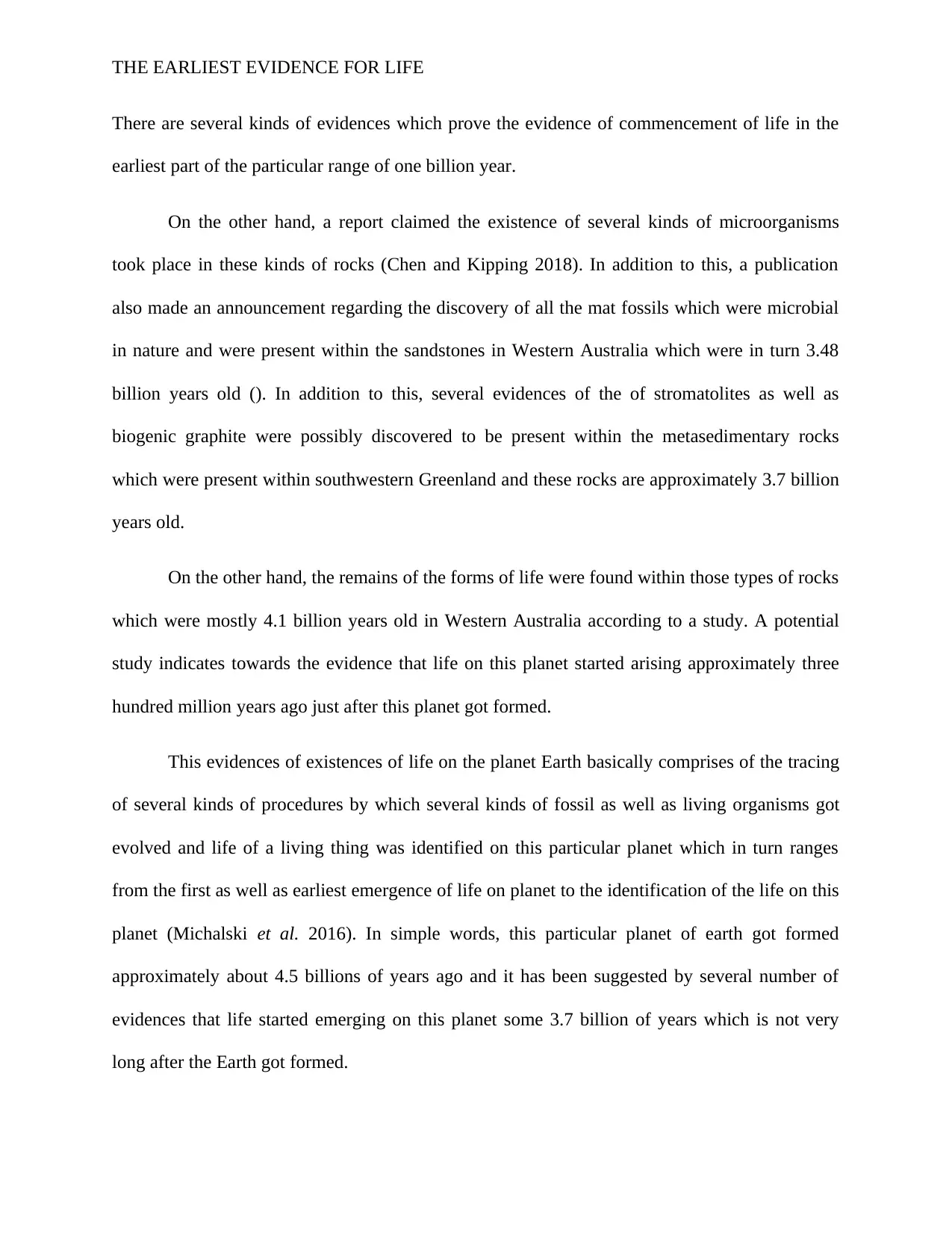
THE EARLIEST EVIDENCE FOR LIFE
There are several kinds of evidences which prove the evidence of commencement of life in the
earliest part of the particular range of one billion year.
On the other hand, a report claimed the existence of several kinds of microorganisms
took place in these kinds of rocks (Chen and Kipping 2018). In addition to this, a publication
also made an announcement regarding the discovery of all the mat fossils which were microbial
in nature and were present within the sandstones in Western Australia which were in turn 3.48
billion years old (). In addition to this, several evidences of the of stromatolites as well as
biogenic graphite were possibly discovered to be present within the metasedimentary rocks
which were present within southwestern Greenland and these rocks are approximately 3.7 billion
years old.
On the other hand, the remains of the forms of life were found within those types of rocks
which were mostly 4.1 billion years old in Western Australia according to a study. A potential
study indicates towards the evidence that life on this planet started arising approximately three
hundred million years ago just after this planet got formed.
This evidences of existences of life on the planet Earth basically comprises of the tracing
of several kinds of procedures by which several kinds of fossil as well as living organisms got
evolved and life of a living thing was identified on this particular planet which in turn ranges
from the first as well as earliest emergence of life on planet to the identification of the life on this
planet (Michalski et al. 2016). In simple words, this particular planet of earth got formed
approximately about 4.5 billions of years ago and it has been suggested by several number of
evidences that life started emerging on this planet some 3.7 billion of years which is not very
long after the Earth got formed.
There are several kinds of evidences which prove the evidence of commencement of life in the
earliest part of the particular range of one billion year.
On the other hand, a report claimed the existence of several kinds of microorganisms
took place in these kinds of rocks (Chen and Kipping 2018). In addition to this, a publication
also made an announcement regarding the discovery of all the mat fossils which were microbial
in nature and were present within the sandstones in Western Australia which were in turn 3.48
billion years old (). In addition to this, several evidences of the of stromatolites as well as
biogenic graphite were possibly discovered to be present within the metasedimentary rocks
which were present within southwestern Greenland and these rocks are approximately 3.7 billion
years old.
On the other hand, the remains of the forms of life were found within those types of rocks
which were mostly 4.1 billion years old in Western Australia according to a study. A potential
study indicates towards the evidence that life on this planet started arising approximately three
hundred million years ago just after this planet got formed.
This evidences of existences of life on the planet Earth basically comprises of the tracing
of several kinds of procedures by which several kinds of fossil as well as living organisms got
evolved and life of a living thing was identified on this particular planet which in turn ranges
from the first as well as earliest emergence of life on planet to the identification of the life on this
planet (Michalski et al. 2016). In simple words, this particular planet of earth got formed
approximately about 4.5 billions of years ago and it has been suggested by several number of
evidences that life started emerging on this planet some 3.7 billion of years which is not very
long after the Earth got formed.
Paraphrase This Document
Need a fresh take? Get an instant paraphrase of this document with our AI Paraphraser

THE EARLIEST EVIDENCE FOR LIFE
In addition to this, it was also discovered that LUCA or last universal common ancestor
might have lived within the hydrothermal vents in the deep sea which approximately ranges from
3.5 billion years old to approximately 3.8 billion years old. In addition to this, it has also become
evident that microfossils or what is frequently referred to as the fossilized microorganisms. The
earliest as well as the oldest evidence of emergence of forms of life on the planet comes out from
the presence of several carbon signatures which are biogenic in nature and possibilities of the
presence of the biotic life additionally took place.
In addition to this, several microbial mats of the coexisting archaea and bacteria took the
dominating roles of existence of life on this planet in the context of the early Epoch of Archaea
along with several important steps in the initial phases of the evolution of the existence of life
which are in turn thought to have occurred in some point of time within the environment (Fischer
and Valentine 2019). On the other hand, the microbial mats which are mentioned above focused
on the procedure of the extraction of the energy directly from the sunlight approximately about
3.5 billion of years ago.
In addition to the evidence of the existence of life on the planet of earth indicates
towards a bunch of rocks located in Greenland which might possess capabilities of holding of the
fossils of the cyanobacteria colonies which are approximately about 3.7 billion years of age. This
in turn form the structures of which are naturally layered and are referred to as stromatolites. The
most interesting fact is that the process of photosynthesis also emerged some 3.5 billion of years
ago after the formation of the planet of Earth which in turn lead to the occurrence of the waste
product. Several numbers of scientists have continuously focused on the Akilia Island rocks as
these rocks might have given an indication of the ancient activities of metabolism by some of the
microbes which were mysterious in nature.
In addition to this, it was also discovered that LUCA or last universal common ancestor
might have lived within the hydrothermal vents in the deep sea which approximately ranges from
3.5 billion years old to approximately 3.8 billion years old. In addition to this, it has also become
evident that microfossils or what is frequently referred to as the fossilized microorganisms. The
earliest as well as the oldest evidence of emergence of forms of life on the planet comes out from
the presence of several carbon signatures which are biogenic in nature and possibilities of the
presence of the biotic life additionally took place.
In addition to this, several microbial mats of the coexisting archaea and bacteria took the
dominating roles of existence of life on this planet in the context of the early Epoch of Archaea
along with several important steps in the initial phases of the evolution of the existence of life
which are in turn thought to have occurred in some point of time within the environment (Fischer
and Valentine 2019). On the other hand, the microbial mats which are mentioned above focused
on the procedure of the extraction of the energy directly from the sunlight approximately about
3.5 billion of years ago.
In addition to the evidence of the existence of life on the planet of earth indicates
towards a bunch of rocks located in Greenland which might possess capabilities of holding of the
fossils of the cyanobacteria colonies which are approximately about 3.7 billion years of age. This
in turn form the structures of which are naturally layered and are referred to as stromatolites. The
most interesting fact is that the process of photosynthesis also emerged some 3.5 billion of years
ago after the formation of the planet of Earth which in turn lead to the occurrence of the waste
product. Several numbers of scientists have continuously focused on the Akilia Island rocks as
these rocks might have given an indication of the ancient activities of metabolism by some of the
microbes which were mysterious in nature.
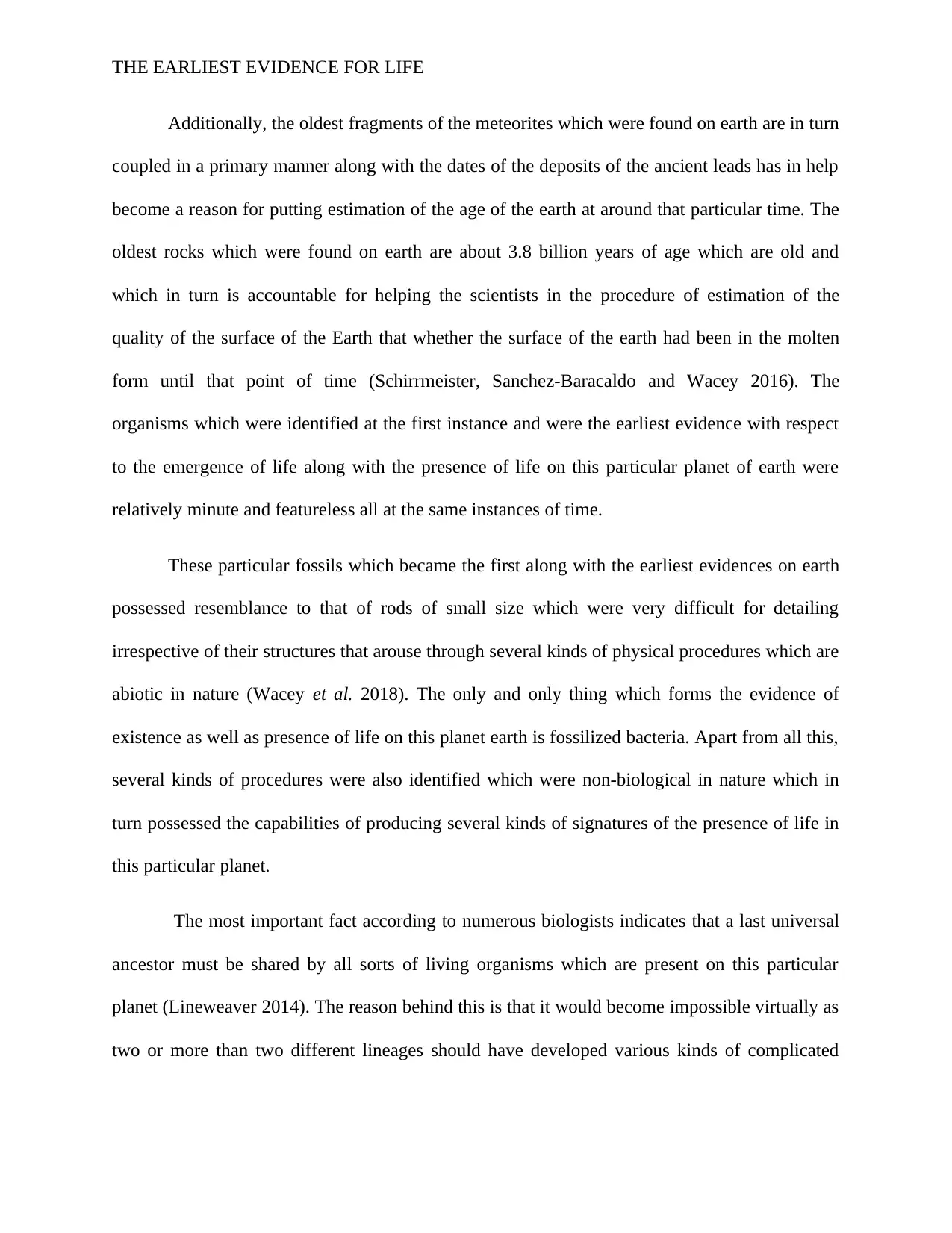
THE EARLIEST EVIDENCE FOR LIFE
Additionally, the oldest fragments of the meteorites which were found on earth are in turn
coupled in a primary manner along with the dates of the deposits of the ancient leads has in help
become a reason for putting estimation of the age of the earth at around that particular time. The
oldest rocks which were found on earth are about 3.8 billion years of age which are old and
which in turn is accountable for helping the scientists in the procedure of estimation of the
quality of the surface of the Earth that whether the surface of the earth had been in the molten
form until that point of time (Schirrmeister, Sanchez-Baracaldo and Wacey 2016). The
organisms which were identified at the first instance and were the earliest evidence with respect
to the emergence of life along with the presence of life on this particular planet of earth were
relatively minute and featureless all at the same instances of time.
These particular fossils which became the first along with the earliest evidences on earth
possessed resemblance to that of rods of small size which were very difficult for detailing
irrespective of their structures that arouse through several kinds of physical procedures which are
abiotic in nature (Wacey et al. 2018). The only and only thing which forms the evidence of
existence as well as presence of life on this planet earth is fossilized bacteria. Apart from all this,
several kinds of procedures were also identified which were non-biological in nature which in
turn possessed the capabilities of producing several kinds of signatures of the presence of life in
this particular planet.
The most important fact according to numerous biologists indicates that a last universal
ancestor must be shared by all sorts of living organisms which are present on this particular
planet (Lineweaver 2014). The reason behind this is that it would become impossible virtually as
two or more than two different lineages should have developed various kinds of complicated
Additionally, the oldest fragments of the meteorites which were found on earth are in turn
coupled in a primary manner along with the dates of the deposits of the ancient leads has in help
become a reason for putting estimation of the age of the earth at around that particular time. The
oldest rocks which were found on earth are about 3.8 billion years of age which are old and
which in turn is accountable for helping the scientists in the procedure of estimation of the
quality of the surface of the Earth that whether the surface of the earth had been in the molten
form until that point of time (Schirrmeister, Sanchez-Baracaldo and Wacey 2016). The
organisms which were identified at the first instance and were the earliest evidence with respect
to the emergence of life along with the presence of life on this particular planet of earth were
relatively minute and featureless all at the same instances of time.
These particular fossils which became the first along with the earliest evidences on earth
possessed resemblance to that of rods of small size which were very difficult for detailing
irrespective of their structures that arouse through several kinds of physical procedures which are
abiotic in nature (Wacey et al. 2018). The only and only thing which forms the evidence of
existence as well as presence of life on this planet earth is fossilized bacteria. Apart from all this,
several kinds of procedures were also identified which were non-biological in nature which in
turn possessed the capabilities of producing several kinds of signatures of the presence of life in
this particular planet.
The most important fact according to numerous biologists indicates that a last universal
ancestor must be shared by all sorts of living organisms which are present on this particular
planet (Lineweaver 2014). The reason behind this is that it would become impossible virtually as
two or more than two different lineages should have developed various kinds of complicated
⊘ This is a preview!⊘
Do you want full access?
Subscribe today to unlock all pages.

Trusted by 1+ million students worldwide

THE EARLIEST EVIDENCE FOR LIFE
mechanisms of biochemistry which are mostly common with respect to all the living organism in
an independent manner.
Apart from the above mentioned factors, the most interesting fact is that presently one
trillion of species exists on this planet out of which only 1.75 to 1.8 million of species have been
named and along with this only 1.6 millions of species have only got documented within the
central database. In other words, it could be said that the earliest along with the first evidence of
the presence and emergence of life on earth. These particular rocks are approximately about 3.95
billion of years of age. Most of the rocks among them have survived directly from the Eorchean
era which mainly ranged from approximately about four to 3.6 billion years of age.
mechanisms of biochemistry which are mostly common with respect to all the living organism in
an independent manner.
Apart from the above mentioned factors, the most interesting fact is that presently one
trillion of species exists on this planet out of which only 1.75 to 1.8 million of species have been
named and along with this only 1.6 millions of species have only got documented within the
central database. In other words, it could be said that the earliest along with the first evidence of
the presence and emergence of life on earth. These particular rocks are approximately about 3.95
billion of years of age. Most of the rocks among them have survived directly from the Eorchean
era which mainly ranged from approximately about four to 3.6 billion years of age.
Paraphrase This Document
Need a fresh take? Get an instant paraphrase of this document with our AI Paraphraser
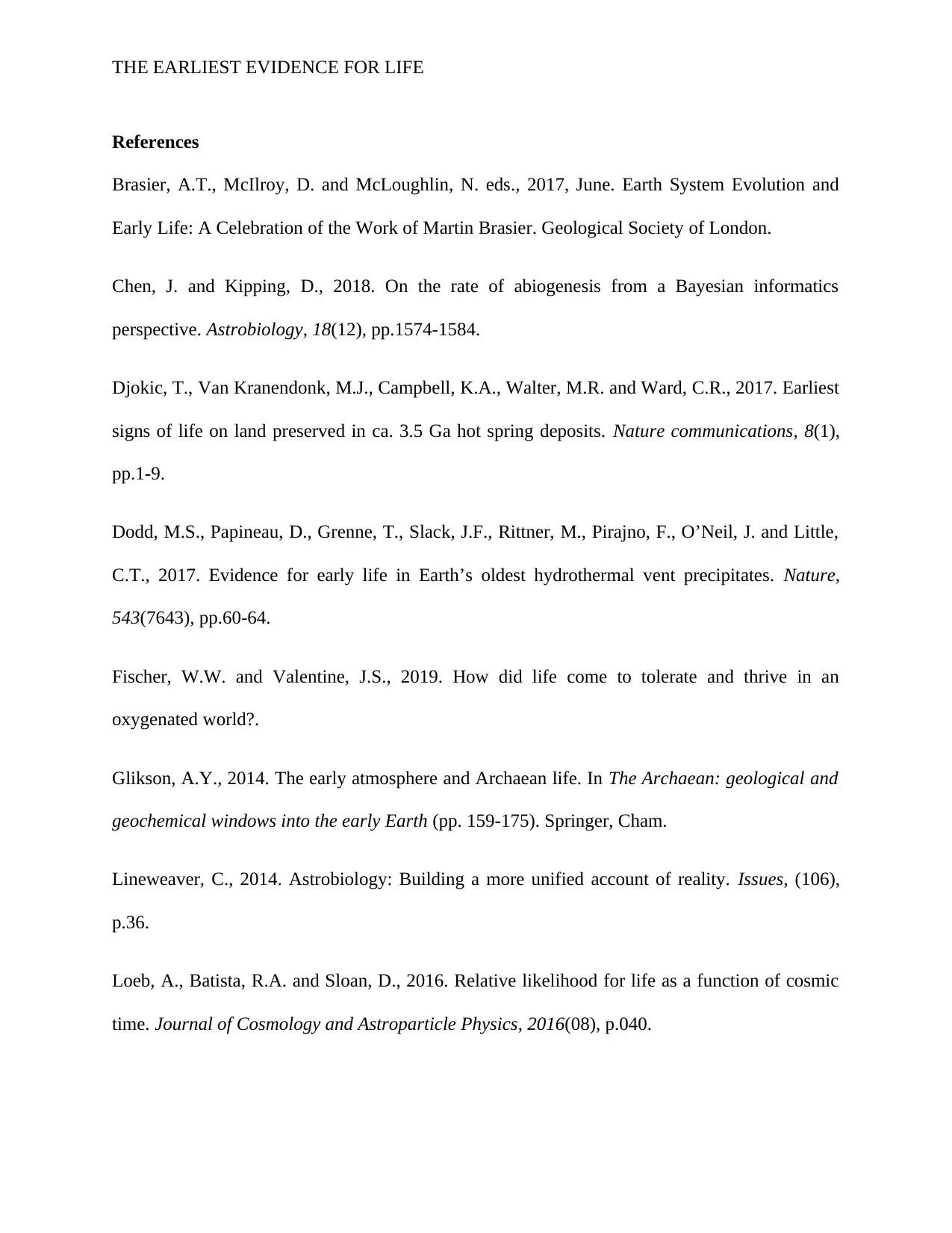
THE EARLIEST EVIDENCE FOR LIFE
References
Brasier, A.T., McIlroy, D. and McLoughlin, N. eds., 2017, June. Earth System Evolution and
Early Life: A Celebration of the Work of Martin Brasier. Geological Society of London.
Chen, J. and Kipping, D., 2018. On the rate of abiogenesis from a Bayesian informatics
perspective. Astrobiology, 18(12), pp.1574-1584.
Djokic, T., Van Kranendonk, M.J., Campbell, K.A., Walter, M.R. and Ward, C.R., 2017. Earliest
signs of life on land preserved in ca. 3.5 Ga hot spring deposits. Nature communications, 8(1),
pp.1-9.
Dodd, M.S., Papineau, D., Grenne, T., Slack, J.F., Rittner, M., Pirajno, F., O’Neil, J. and Little,
C.T., 2017. Evidence for early life in Earth’s oldest hydrothermal vent precipitates. Nature,
543(7643), pp.60-64.
Fischer, W.W. and Valentine, J.S., 2019. How did life come to tolerate and thrive in an
oxygenated world?.
Glikson, A.Y., 2014. The early atmosphere and Archaean life. In The Archaean: geological and
geochemical windows into the early Earth (pp. 159-175). Springer, Cham.
Lineweaver, C., 2014. Astrobiology: Building a more unified account of reality. Issues, (106),
p.36.
Loeb, A., Batista, R.A. and Sloan, D., 2016. Relative likelihood for life as a function of cosmic
time. Journal of Cosmology and Astroparticle Physics, 2016(08), p.040.
References
Brasier, A.T., McIlroy, D. and McLoughlin, N. eds., 2017, June. Earth System Evolution and
Early Life: A Celebration of the Work of Martin Brasier. Geological Society of London.
Chen, J. and Kipping, D., 2018. On the rate of abiogenesis from a Bayesian informatics
perspective. Astrobiology, 18(12), pp.1574-1584.
Djokic, T., Van Kranendonk, M.J., Campbell, K.A., Walter, M.R. and Ward, C.R., 2017. Earliest
signs of life on land preserved in ca. 3.5 Ga hot spring deposits. Nature communications, 8(1),
pp.1-9.
Dodd, M.S., Papineau, D., Grenne, T., Slack, J.F., Rittner, M., Pirajno, F., O’Neil, J. and Little,
C.T., 2017. Evidence for early life in Earth’s oldest hydrothermal vent precipitates. Nature,
543(7643), pp.60-64.
Fischer, W.W. and Valentine, J.S., 2019. How did life come to tolerate and thrive in an
oxygenated world?.
Glikson, A.Y., 2014. The early atmosphere and Archaean life. In The Archaean: geological and
geochemical windows into the early Earth (pp. 159-175). Springer, Cham.
Lineweaver, C., 2014. Astrobiology: Building a more unified account of reality. Issues, (106),
p.36.
Loeb, A., Batista, R.A. and Sloan, D., 2016. Relative likelihood for life as a function of cosmic
time. Journal of Cosmology and Astroparticle Physics, 2016(08), p.040.

THE EARLIEST EVIDENCE FOR LIFE
Michalski, J.R., Niles, P.B., Rogers, A.D., Johnson, S.S., Ashley, J.W. and Golombek, M.P.,
2016. Geology of McLaughlin Crater, Mars: A Unique Lacustrine Setting with Implications for
Astrobiology.
Nutman, A.P., Bennett, V.C., Friend, C.R., Van Kranendonk, M.J. and Chivas, A.R., 2016.
Rapid emergence of life shown by discovery of 3,700-million-year-old microbial structures.
Nature, 537(7621), pp.535-538.
Scerri, E.M., Drake, N.A., Jennings, R. and Groucutt, H.S., 2014. Earliest evidence for the
structure of Homo sapiens populations in Africa. Quaternary Science Reviews, 101, pp.207-216.
Scharf, C., Virgo, N., Cleaves, H.J., Aono, M., Aubert-Kato, N., Aydinoglu, A., Barahona, A.,
Barge, L.M., Benner, S.A., Biehl, M. and Brasser, R., 2015. A strategy for origins of life
research.
Schirrmeister, B.E., Sanchez-Baracaldo, P. and Wacey, D., 2016. Cyanobacterial evolution
during the Precambrian. International Journal of Astrobiology, 15(3), pp.187-204.
Wacey, D., Urosevic, L., Saunders, M. and George, A.D., 2018. Mineralisation of filamentous
cyanobacteria in Lake Thetis stromatolites, Western Australia. Geobiology, 16(2), pp.203-215.
Michalski, J.R., Niles, P.B., Rogers, A.D., Johnson, S.S., Ashley, J.W. and Golombek, M.P.,
2016. Geology of McLaughlin Crater, Mars: A Unique Lacustrine Setting with Implications for
Astrobiology.
Nutman, A.P., Bennett, V.C., Friend, C.R., Van Kranendonk, M.J. and Chivas, A.R., 2016.
Rapid emergence of life shown by discovery of 3,700-million-year-old microbial structures.
Nature, 537(7621), pp.535-538.
Scerri, E.M., Drake, N.A., Jennings, R. and Groucutt, H.S., 2014. Earliest evidence for the
structure of Homo sapiens populations in Africa. Quaternary Science Reviews, 101, pp.207-216.
Scharf, C., Virgo, N., Cleaves, H.J., Aono, M., Aubert-Kato, N., Aydinoglu, A., Barahona, A.,
Barge, L.M., Benner, S.A., Biehl, M. and Brasser, R., 2015. A strategy for origins of life
research.
Schirrmeister, B.E., Sanchez-Baracaldo, P. and Wacey, D., 2016. Cyanobacterial evolution
during the Precambrian. International Journal of Astrobiology, 15(3), pp.187-204.
Wacey, D., Urosevic, L., Saunders, M. and George, A.D., 2018. Mineralisation of filamentous
cyanobacteria in Lake Thetis stromatolites, Western Australia. Geobiology, 16(2), pp.203-215.
⊘ This is a preview!⊘
Do you want full access?
Subscribe today to unlock all pages.

Trusted by 1+ million students worldwide
1 out of 9
Your All-in-One AI-Powered Toolkit for Academic Success.
+13062052269
info@desklib.com
Available 24*7 on WhatsApp / Email
![[object Object]](/_next/static/media/star-bottom.7253800d.svg)
Unlock your academic potential
Copyright © 2020–2025 A2Z Services. All Rights Reserved. Developed and managed by ZUCOL.
